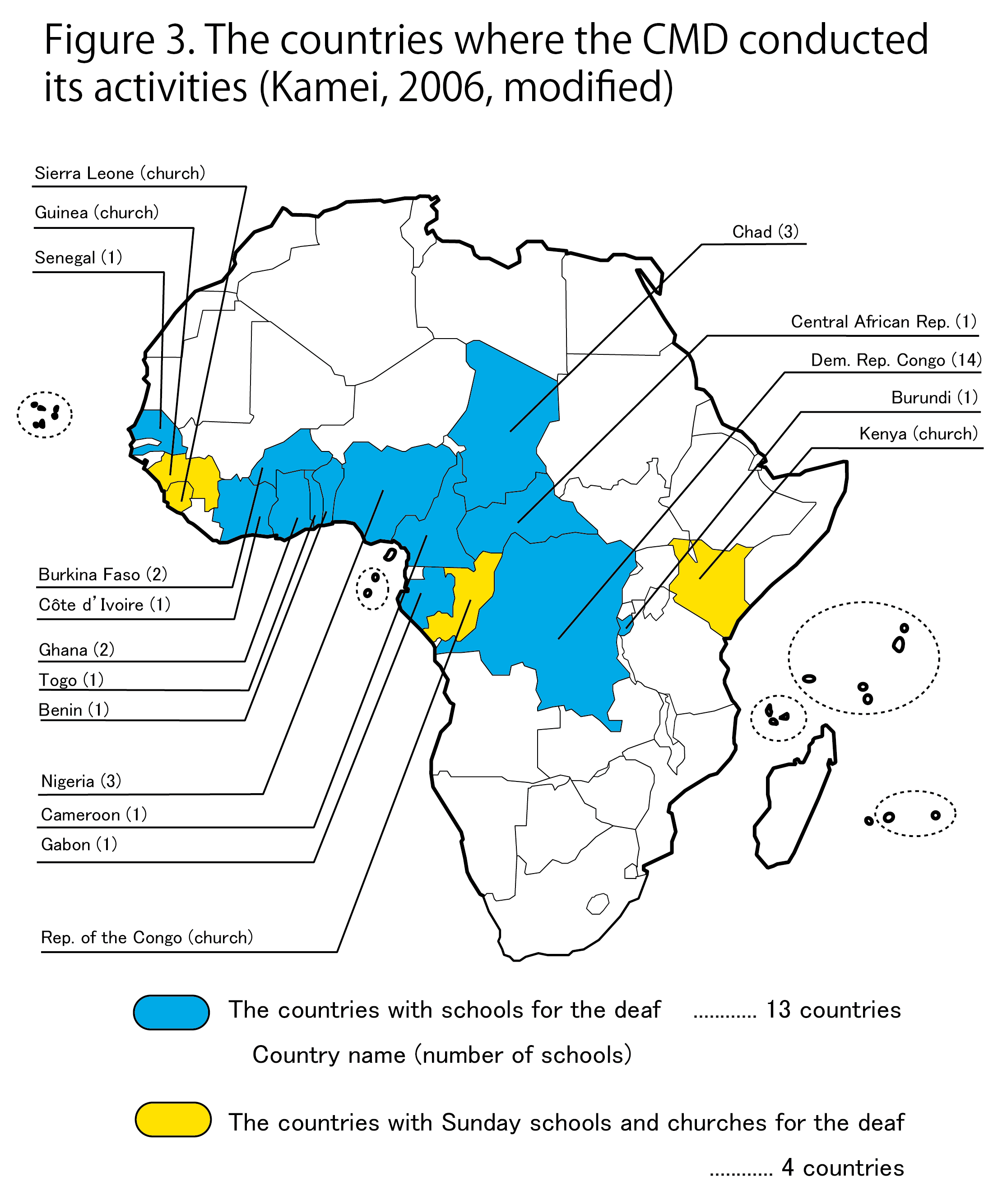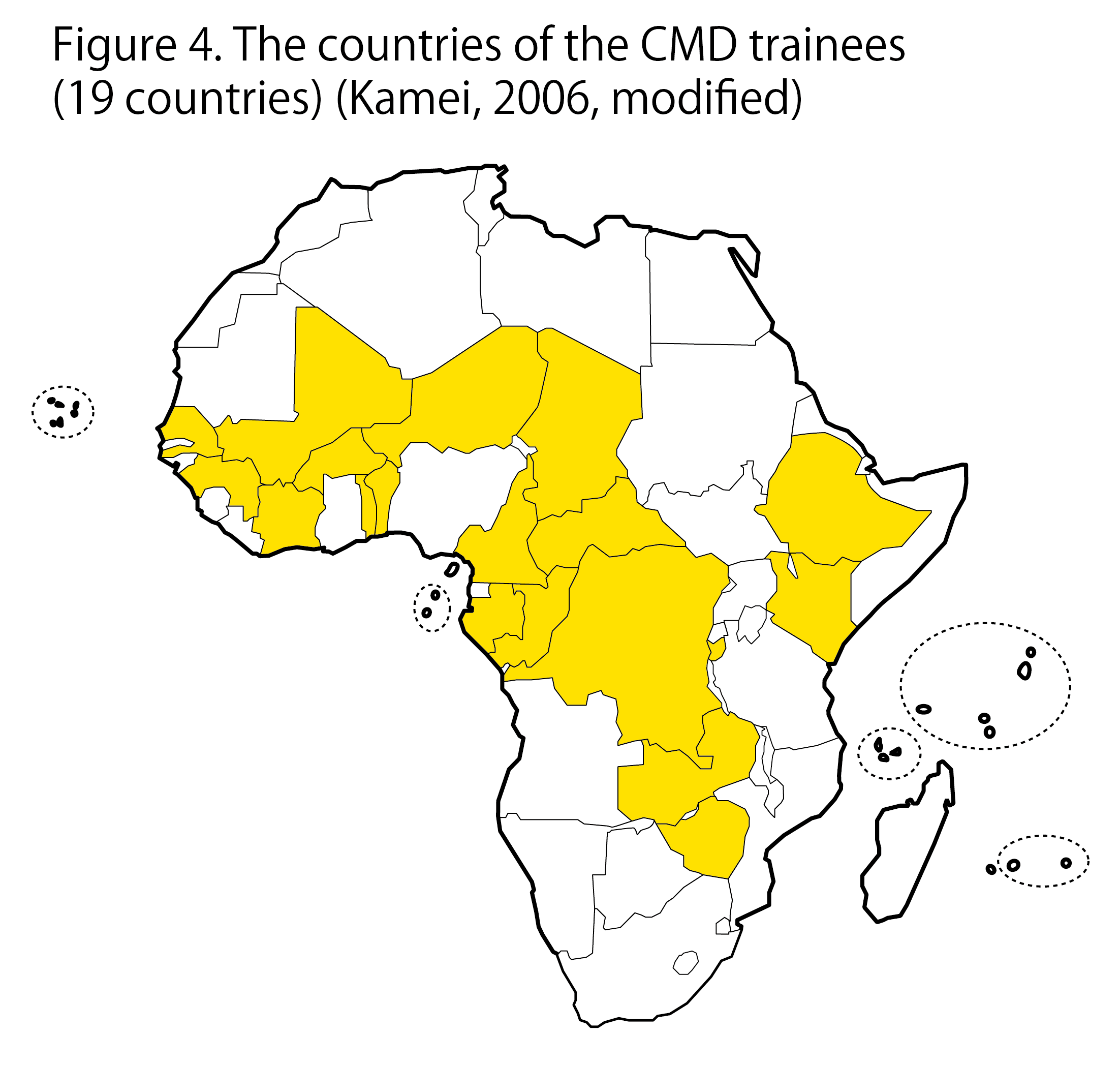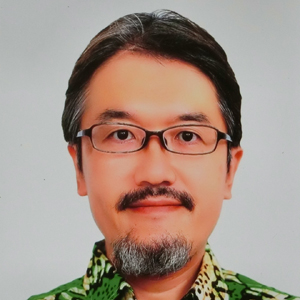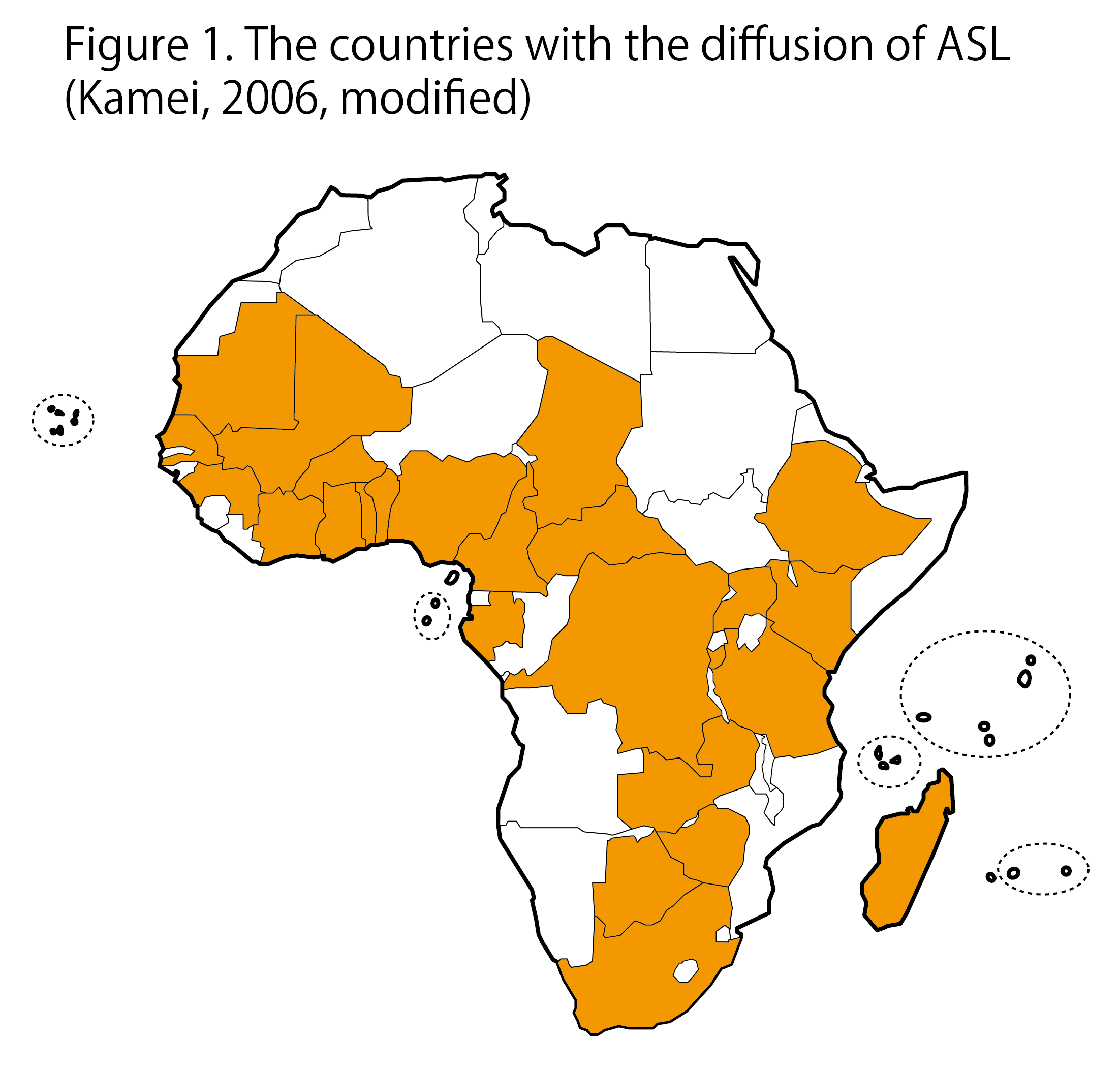Nobutaka KameiAnthropological Research on Sign Languages in French-Speaking West and Central Africa(07/12/2017)
KeywordsSign language; Langue des Signes d’Afrique Francophone (LSAF); Deaf community
Introduction: Diffusion of American Sign Language in French-speaking AfricaThis paper outlines my anthropological research on sign languages in West and Central Africa since 1997 and points out future issues in this domain.
American Sign Language (ASL) is said to be widespread in Africa, not only in English-speaking countries, but also in French-speaking countries. Figure 1 shows African countries whose sign languages were influenced by ASL and Figure 2 shows twenty-two African countries that have adopted French as an official language. Through the comparison of these figures, we can see that ASL has spread to most French-speaking African countries. America had no involvement in the colonization and rule of Africa in the 19th to 20th centuries. The historical background of these phenomena and the actualities of the sign languages that are used today in Deaf communities need to be clarified. I have conducted fieldwork in Deaf communities in nine African countries (from west to east: Senegal, Burkina Faso, Côte d’Ivoire, Ghana, Togo, Benin, Nigeria, Cameroon, and Gabon) for twenty years, using their sign languages. Historical backgroundThe key actor in the diffusion of ASL in Africa was Andrew J. Foster (1925–1987). He was a Deaf African-American pastor. Foster founded the Christian Mission for the Deaf (CMD) and worked in many African countries to spread school education and Christianity to the Deaf. He is often called “the father of Deaf education in Africa”.
 Figure 3 shows the distribution of schools founded by the CMD. The CMD founded thirty-one schools for the Deaf in thirteen countries, also founding churches and Sunday schools in four countries. Foster is well known as having founded the most schools for the Deaf worldwide. The network of CMD schools had a presence in almost every major city in West and Central Africa, such as Accra (Ghana), Ibadan (Nigeria), Abidjan (Côte d’Ivoire), Ouagadougou (Burkina Faso), Cotonou (Benin), Lomé (Togo), Dakar (Senegal), N’Djamena (Chad), Bangui (Central African Republic), Kinshasa (Democratic Republic of the Congo), and Libreville (Gabon). Of these thirty-one schools, twenty-five (about 80%) were founded in French-speaking areas. CMD teacher-training courseThe CMD also trained young teachers, reaching one hundred sixty-one trainees in the teacher-training courses organized by Foster. The majority of these trainees were said to be Deaf.
 Figure 4 shows the countries of origin of these one hundred sixty-one trainees. These connections created an extensive and effective network on the African continent, constructed by the CMD. Comparison of Figures 2 and 4 shows clearly that the network covers most French-speaking countries in Africa. The training of the teachers was managed by Deaf people themselves. The founder of the CMD and manager of the course was Andrew Foster (Deaf), the instructors were Deaf teachers from Benin, and the trainees were Deaf and hearing students from nineteen countries, including most French-speaking African countries. These trainees themselves became teachers of Deaf children in their homelands.
Definition of Langue des Signes d’Afrique FrancophoneAfter this diffusion of ASL among African countries, the ASL vocabulary spread widely and rapidly among urban Deaf communities in these areas. These Deaf communities adopted the grammar, spelling, and mouthing of spoken and written French. The Deaf communities also added rich signs created among them in everyday life.
 This process can be explained by reference to Figure 5. During the era of colonization, spoken and written French was introduced in Africa by the colonizing power, France. After these countries attained independence, ASL was introduced from America through educational activities by Deaf educators. Finally, a new sign language was created in the zone of language contact between ASL and French. In discussions over many years, we, that is I and my Deaf African counterparts, began to recognize this language not as a dialect of ASL, but as a new independent language created by African Deaf communities. We have termed this language Langue des Signes d’Afrique Francophone (LSAF). The following is our proposed definition of LSAF: Langue des Signes d’Afrique Francophone (LSAF) is a generic term for the sign languages used in Deaf communities in French-speaking West and Central Africa with (1) loan signs from ASL and (2) the influence of spoken/written French.
Thus, LSAF can be thought of as a generic term for contact sign languages emerging in the interaction zone of ASL and French in Africa. I have visited Deaf communities in seven French-speaking African countries. A common sign language (LSAF) can be observed to surpass political borders here. However, minor variations in vocabulary can be found. For this reason, we have determined the use of geographic names to distinguish one dialect from another (for example, “LSAF-CI” as the dialect of LSAF used in Côte d’Ivoire). Ongoing research project (1): Dictionaries in Cameroon and Côte d’IvoireWith the recognition of LSAF as an independent language originating in the contact zone of ASL and French, it is necessary to conduct descriptive research on this language.
As part of a research project of the Research Institute for Languages and Cultures of Asia and Africa, Tokyo University of Foreign Studies (ILCAA-TUFS), Japan, creation of the first dictionary of LSAF was begun in 2007. The first DVD video dictionary of LSAF was created in 2008 with the collaboration of the Deaf community in Cameroon (Kamei ed., 2008). It is an electronic dictionary of LSAF using video clips, with indices in Japanese and French. This DVD contains about 3,300 clips (7 hours 40 minutes). After the project in Cameroon, I started another project in Côte d’Ivoire (ongoing from 2008 to the present). In 2008, we started to promote the idea of a project for a second LSAF dictionary in Côte d’Ivoire. In 2009, we started research training with Deaf counterparts in Abidjan. Deaf counterparts interested in descriptive research on sign language began to participate in our workshop. Ongoing research project (2): Deaf communities after Foster’s deathIn 1987, Foster died in an aircraft crash in Rwanda. Some schools were nationalized and others continued as private schools. Some schools were taken over by hearing educators and others by Deaf educators. We can find various patterns and outcomes related to the empowerment of Deaf communities through the examination of CMD schools after Foster’s death.
Through research on Deaf education in the post-Foster era, we can classify the outcomes of these schools and their education using two criteria:
Conclusion: Summary and future issuesIn summary, I highlight the following. ASL use is widespread in West and Central Africa. However, this usage is not the result of colonization by European powers. It is the result of missionary work conducted mainly by Deaf Africans after the independence of African countries. African Deaf communities have created a new sign language (LSAF), borrowing from ASL vocabulary, spoken/written French, and original signs created in Africa.
As future issues related to these results, I point out three topics: (1) descriptive studies of LSAF in every African country in the CMD zone, focusing on their diversity; (2) clarification of the detailed history of the Deaf communities through interviews with Deaf Africans in their sign languages; and (3) anthropological studies of the diversity of African Deaf culture using participant observation methods.
In the EHESS project in France, I will create a network of researchers who are interested in the languages, culture, and history of African Deaf communities to promote this research domain. Comparative studies of sign languages and Deaf cultures in Africa, Europe, and Asia can be promoted through such research based on fieldwork conducted throughout the world. AcknowledgmentsThe field research for this paper was conducted with support from several Grants-in-Aid for Scientific Research “KAKENHI” from the Japan Society for the Promotion of Science (JSPS) and Aichi Prefectural University, Japan. It is a pleasure to express our sense of thanks to: the sign language research group in Côte d’Ivoire, the sign language research group in Cameroon, all Deaf and hearing counterparts in Africa, Université Félix Houphouët-Boigny, Côte d’Ivoire, Professor Rémy Bazenguissa-Ganga, Ms. Kae Amo and all the colleagues and staff of the École des hautes études en sciences sociales (EHESS).
ReferencesChristian Mission for the Deaf (CMD) [Christian Mission for Deaf Africans (CMDA)]. 1957-2006. Untitled newsletters (1957-1960); Silent Witness (1961-1969); Deaf Witness (1970-today). Accra (Ghana); Ibadan (Nigeria); Flint (MI, USA); Detroit (MI, USA). Christian Mission for the Deaf (CMD). http://www.cmdeaf.org/ Kamei, Nobutaka. 2006. History of Deaf people and sign languages in Africa: Fieldwork in the “kingdom” derived from Andrew J. Foster. Tokyo: Akashi Shoten. [In Japanese] Kamei, Nobutaka ed. 2008. DVD: Langue des Signes d’Afrique Francophone (LSAF). Fuchu: Research Institute for Languages and Cultures of Asia and Africa, Tokyo University of Foreign Studies. [In Langue des Signes d’Afrique Francophone (LSAF), French, Japanese] Sanogo, Yédê Adama ed. Supervisor: Kamei, Nobutaka. 2012. Ecoute mes mains: dictionnaire de langue des signes. Abidjan, Côte d’Ivoire: EDILIS. Sanogo, Yédê Adama & Nobutaka Kamei. 2017. Promotion of sign language research by the African Deaf community: Cases in French-speaking West and Central Africa. In: Kaji, Shigeki ed. Proceedings of the 8th World Congress of African Linguistics. Fuchu: Research Institute for Languages and Cultures of Asia and Africa, Tokyo University of Foreign Studies. 411-424. |
 |
Recherche |  |
FFJ Research Statement |  |
Nobutaka Kamei |
| Inscrivez-vous à notre Lettre en cliquant ici |
*En cas de problème, vous pouvez aussi vous inscrire en envoyant un mail à sympa@ehess.fr, avec pour titre "subscribe ffj_french_news".








